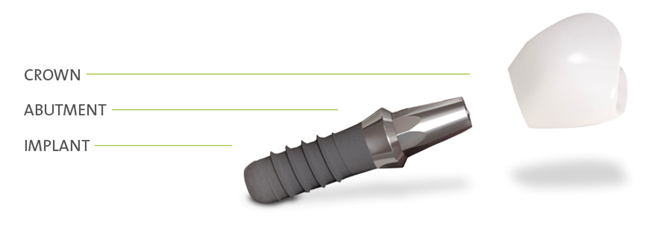Patient Articles
What is a dental implant?
The decision to replace missing teeth with dental implants is an excellent investment in your oral health and appearance. Dental implants are now the standard of care for missing teeth. Better than older versions of crown and bridge solutions, today’s dental implants look, feel and function like natural teeth. They help prevent bone loss caused by missing tooth roots and do not require adjacent teeth to be ground down.
Technically, a dental implant is a small, but very strong post made from biocompatible metals or ceramics, and is made up of three components: the dental implant, the abutment, and the crown.
The dental implant is a small post, usually made of titanium, and similar in shape to screws. Under local anesthetic, it is surgically inserted into the jawbone, and serves as the first step in the process to replace missing teeth. Once inserted, the dental implant bonds with the natural bone, acts as a substitute for the root of the tooth, and provides the base of support for the one or more replacement teeth, also known as the crowns.
The abutment is a connector that is placed on, or built into, the top of the dental implant, and serves as the connection point and additional support for the crown.
The crown, essentially the replacement tooth, is custom manufactured to match the look, shape, and fit of the other natural teeth, and then installed onto the abutment to complete the replacement process.

Dental implant procedures generally follow a series of standard steps, and take more than one visit to complete. A licensed dental professional will first make an assessment of the patient, which includes a patient history, completion of a dental examination, and discussion of a full treatment plan. Because each patient is different, total treatment time depends on individual patients needs, medical and dental history, jawbone condition, and the technique and materials that are being used. It can be as short as a few months, or more than a year to complete more complex conditions.
The next step is the insertion of the dental implant, which done under local anesthesia. After dental implant surgery, patients need time to heal and have any sutures removed before moving onto the next phase of restoration. A temporary restoration may be placed on the dental implant at time of surgery for the healing stage.
The healing phase usually lasts between a couple of weeks and a few months. Ideally during this period the bone around the dental implant grows and integrates with the dental implant surface – a process called osseointegration. Good oral hygiene is vital in the healing stage of the treatment. Once healed, this artificial root acts as a base for fixing individual crowns, multi-tooth bridges, or an entire dental prosthesis.
Once sufficient healing has occurred, the dental professional takes an impression of the dental implant site that will be sent to a lab to produce a crown (or bridge if multiple teeth are being replaced) that is custom-fit to the patient’s mouth. Once fabrication is complete, the crown or bridge is installed.
Today’s state-of-the-art restoration products and techniques cover all patient needs – whether one tooth needs to be replaced, or all of them. Unlike other tooth replacement options, dental implants are the most natural looking and feeling, and won’t slip or cause concern during talking, eating or laughing. They have been scientifically tested and used in the last three decades by qualified dentists and surgeons worldwide. When performed by a trained and experienced dental implant dentist, dental implant surgery is one of the safest and most predictable procedures in dentistry
Looking to find the right
dental procedure
for you?
Take a Quiz to find out 

Take a quiz


